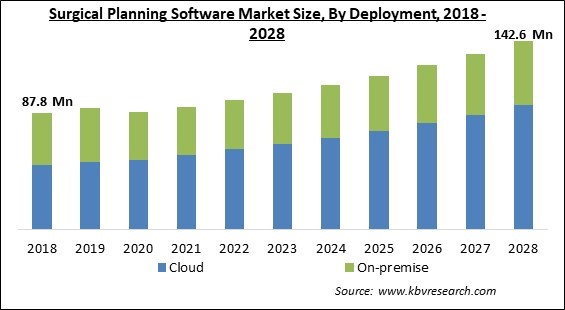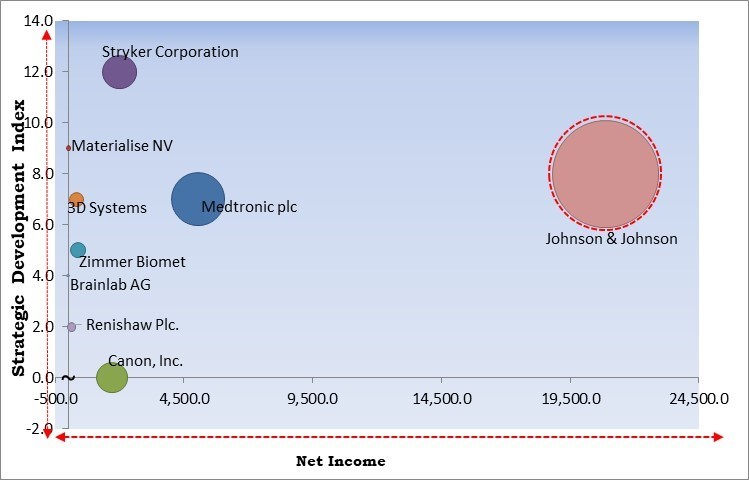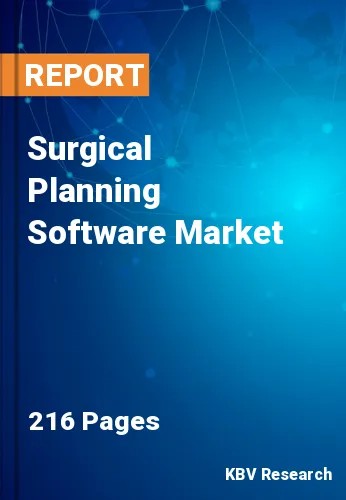The Global Surgical Planning Software Market size is expected to reach $142.6 Million by 2028, rising at a market growth of 6.5% CAGR during the forecast period.
Surgical planning software generates digitally correct data that the surgeon may rapidly assess prior to surgery, assisting the physician in selecting the best surgical strategy. Some of the major reasons influencing the market growth include an increase in orthopedic surgery cases, technical advancements related to surgical planning software, and an increase in the global geriatric population.

Software for pre-operative planning in surgery helps doctors comprehend and concentrate on the relevant modalities, such as joint repair, fracture pattern, deformity, and others. Through the use of this software, surgeons may mentally prepare and practice the procedure. Furthermore, with its assistance, future problems may be predicted and avoided. Additionally, in the event that problems with this program arise, alternate surgical plans might be put into practice.
Pre-operative planning for surgery numerous treatments, including those in orthopedics and neurology, are managed by software. Software for pre-operative surgical planning aids the surgeon in selecting the best surgical technique. Usually, this program is used to design orthopedic surgeries like hip, knee, or joint replacements. Additionally, this program may be used to treat bone abnormalities and control injuries.
Software for pre-operative surgical planning directs orthopedic surgery and helps doctors carry out their plans more successfully. This program produces digitally accurate data that the surgeon may easily assess before the procedure. Doctors may use this program to mentally prepare and rehearse the operation. Furthermore, if issues emerge while using this program, alternative surgical plans may be created.
The spread of the new coronavirus (COVID-19) has had an adverse effect on the majority of industries and the global economy. The surgical planning software industry was somewhat impacted by the COVID-19 outbreak. As the world's healthcare systems fought to contain the initial wave of COVID-19, several governments took the essential choice to postpone all non-emergency surgical procedures in order to free up people and resources for patients infected by the virus. This resulted in fewer hospital admissions and the cancellation of a sizable number of elective procedures. Despite this, the market quickly rebounded as limitations were loosened and elective procedures that had been put off during the pandemic began again.
WHO estimates that by 2030, 1 in 6 individuals worldwide would be 60 years of age or older. By this point, there will be 1.4 billion people over the age of 60, up from 1 billion in 2020. The number of persons in the globe who are 60 years or older will double by 2050. (2.1 billion). Between 2020 and 2050, the number of people 80 or older is projected to triple, reaching 426 million. Two-thirds of the world's population over 60 will reside in low- and middle-income nations by the year 2050. The elderly are more likely to have serious injuries that may need surgery. As a consequence, there will be an increase in the number of procedures performed due to the growing elderly population throughout the world, necessitating the use of surgical planning software.
The increasing quantity and magnitude of investments made in the healthcare sector by governments of different nations is one of the primary drivers of the market's growth. Because of their rapid economic growth and rising healthcare expenses, it is projected that more emerging countries would have more access to high-quality healthcare. This is seen as a sign that the market for surgical planning software is growing favourably. Due to the increase in health conditions, these countries now have a greater need than ever for different treatments and equipment. The market is growing as a result of the rising investment in the healthcare industry.
The global health workforce, based on statistics from 194 Member States as of 2020, is anticipated to reach 65 million, representing an increase of 29% since the adoption of the Global Strategy on Human Resources for Health: Workforce 2030 in 2016. By 2030, the WHO predicts a 10 million-person shortage in the health workforce, mostly in low- and lower-middle-income nations. To varied degrees, nations at all socioeconomic levels have challenges with regard to the training, employment, retention, deployment, and efficiency of their workforce. The market for surgical planning software will diminish since there is already a shortage of trained workers, which is expected to persist in the coming years.
Based on deployment, the surgical planning software market is segmented into cloud-based and on-premise versions depending on deployment. The cloud segment generated the most revenue share in the Surgical Planning Software Market in 2021. Software that is hosted in the cloud offers improved benefits like access to a larger selection of apps, including development tools, on-demand processing cycles, and application storage. Applications in the cloud may function entirely or partially offline, which is advantageous for platforms with sluggish internet connections.

Based on application, the surgical planning software market is divided into orthopedic surgery, neurosurgery, dentistry & orthodontics, and others. The orthopedic surgery segment accounted for the largest revenue share in 2021. One of the most important pre-operative processes in surgery is planning. Pre-operative planning may help reduce operating hours and hospital stays for elective surgical procedures like total joint replacements (LOS). Recent technological developments aim to assist orthopedic surgeons in planning their operations more precisely and enhancing intra-operative precision.
Based on End-use, the surgery planning software market is divided into hospitals and clinics & others. The clinics & others segment showcased the considerable revenue share in 2021. One of the most important aspects in therapy is employing surgical planning software for pre-operative orthopedicplanning. It improves patient communication, lowers the chance of intraoperative difficulties, and enables orthopedic surgeons to prepare for joint replacement surgery and other orthopedic therapies. These benefits may also directly help the hospital, from improved implant supply management to a significant decrease in challenges and patient complaints.
| Report Attribute | Details |
|---|---|
| Market size value in 2021 | USD 92.9 Million |
| Market size forecast in 2028 | USD 142.6 Million |
| Base Year | 2021 |
| Historical Period | 2018 to 2020 |
| Forecast Period | 2022 to 2028 |
| Revenue Growth Rate | CAGR of 6.5% from 2022 to 2028 |
| Number of Pages | 216 |
| Number of Tables | 344 |
| Report coverage | Market Trends, Revenue Estimation and Forecast, Segmentation Analysis, Regional and Country Breakdown, Competitive Landscape, Companies Strategic Developments, Company Profiling |
| Segments covered | Deployment, Application, End-use, Region |
| Country scope | US, Canada, Mexico, Germany, UK, France, Russia, Spain, Italy, China, Japan, India, South Korea, Singapore, Malaysia, Brazil, Argentina, UAE, Saudi Arabia, South Africa, Nigeria |
| Growth Drivers |
|
| Restraints |
|
Based on region, the surgical planning software market categorized into North America, Europe, Asia Pacific, and LAMEA. In 2021, the North America region garnered the highest revenue share in the surgical planning software market in 2021. The fast technical breakthroughs in the medical field and the area's highly advanced health infrastructure are responsible for the region's growth. The growth rate of the North America surgical planning software industry over the last several years has been significantly impacted by the allocation of money for medical research and development. The market is anticipated to grow as a result of the many health initiatives launched by several institutions and organizations.
Free Valuable Insights: Global Surgical Planning Software Market size to reach USD 142.6 Million by 2028

The major strategies followed by the market participants are Product Launches. Based on the Analysis presented in the Cardinal matrix; Johnson & Johnson (DePuy Synthes) is the forerunner in the Surgical Planning Software Market. Companies such as Medtronic PLC, Stryker Corporation, and 3D Systems Corporation are some of the key innovators in Surgical Planning Software Market.
The market research report covers the analysis of key stake holders of the market. Key companies profiled in the report include Stryker Corporation, Zimmer Biomet Holdings, Inc., Medtronic plc, Materialise NV, Brainlab AG, 3D Systems Corporation, Renishaw Plc., Johnson & Johnson (DePuy Synthes), Canon, Inc. (Canon Medical Systems Corporation), and General Electric (GE) Co. (GE Healthcare).
By Deployment
By End Use
By Application
By Geography
The global Surgical Planning Software Market size is expected to reach $142.6 Million by 2028.
Increasing old aged population are driving the market in coming years, however, Lack of professionals restraints the growth of the market.
Stryker Corporation, Zimmer Biomet Holdings, Inc., Medtronic plc, Materialise NV, Brainlab AG, 3D Systems Corporation, Renishaw Plc., Johnson & Johnson (DePuy Synthes), Canon, Inc. (Canon Medical Systems Corporation), and General Electric (GE) Co. (GE Healthcare).
The Hospitals segment is leading the Global Surgical Planning Software Market by End-use in 2021, thereby, achieving a market value of $79.7 Million by 2028.
The North America market dominated the Global Surgical Planning Software Market by Region in 2021, and would continue to be a dominant market till 2028; thereby, achieving a market value of $60.6 Million by 2028.
Our team of dedicated experts can provide you with attractive expansion opportunities for your business.

